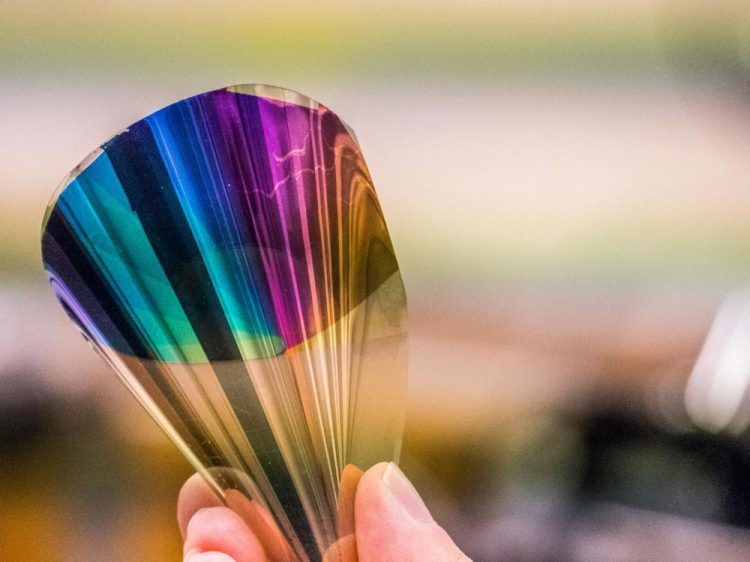Bendable electronic paper displays whole color range

Chalmers' e-paper contains gold, silver and PET plastic. The layer that produces the colours is less than a micrometre thin. Credit: Mats Tiborn
When Chalmers researcher Andreas Dahlin and his PhD student Kunli Xiong were working on placing conductive polymers on nanostructures, they discovered that the combination would be perfectly suited to creating electronic displays as thin as paper. A year later the results were ready for publication. A material that is less than a micrometre thin, flexible and giving all the colours that a standard LED display does.
“The 'paper' is similar to the Kindle tablet”, says Andreas Dahlin. “It isn't lit up like a standard display, but rather reflects the external light which illuminates it. Therefore it works very well where there is bright light, such as out in the sun, in contrast to standard LED displays that work best in darkness. At the same time it needs only a tenth of the energy that a Kindle tablet uses, which itself uses much less energy than a tablet LED display”.
It all depends on the polymers' ability to control how light is absorbed and reflected. The polymers that cover the whole surface lead the electric signals throughout the full display and create images in high resolution. The material is not yet ready for application, but the basis is there. The team has tested and built a few pixels. These use the same red, green and blue (RGB) colours that together can create all the colours in standard LED displays. The results so far have been positive, what remains now is to build pixels that cover an area as large as a display.
“We are working at a fundamental level but even so, the step to manufacturing a product out of it shouldn't be too far away. What we need now are engineers”.
One obstacle today is that there is gold and silver in the display, which makes the manufacturing expensive.
“The gold surface is 20 nanometres thick so there is not that much gold in it”, says Andreas Dahlin. “But at present there is a lot of gold wasted in manufacturing it. Either we reduce the waste or we find another way to decrease the manufacturing cost”.
Andreas Dahlin thinks the best application for the displays will be well-lit places such as outside or in public places to display information. This could reduce the energy consumption and at the same time replace signs and information screens that aren't currently electronic today with more flexible ones.
Media Contact
All latest news from the category: Materials Sciences
Materials management deals with the research, development, manufacturing and processing of raw and industrial materials. Key aspects here are biological and medical issues, which play an increasingly important role in this field.
innovations-report offers in-depth articles related to the development and application of materials and the structure and properties of new materials.
Newest articles

A universal framework for spatial biology
SpatialData is a freely accessible tool to unify and integrate data from different omics technologies accounting for spatial information, which can provide holistic insights into health and disease. Biological processes…

How complex biological processes arise
A $20 million grant from the U.S. National Science Foundation (NSF) will support the establishment and operation of the National Synthesis Center for Emergence in the Molecular and Cellular Sciences (NCEMS) at…

Airborne single-photon lidar system achieves high-resolution 3D imaging
Compact, low-power system opens doors for photon-efficient drone and satellite-based environmental monitoring and mapping. Researchers have developed a compact and lightweight single-photon airborne lidar system that can acquire high-resolution 3D…





















